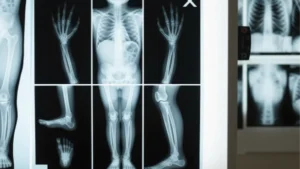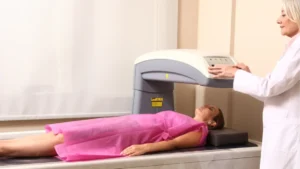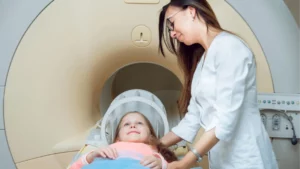Breast cancer is the most common type of cancer among women in the United States. Today, studies have shown that 1 in 8 (or 13%) American women has a chance of developing breast cancer. Although most common in women, 1 in 1000 men can still get it as well.
October is Breast Cancer Awareness Month. This is an annual campaign to increase the awareness of the impacts of breast cancer and to promote the importance of breast cancer screening.
One Step Diagnostic takes part in the campaign for breast cancer awareness by offering breast cancer diagnostic services and sharing valuable information on the disease such as what to look out for and how you can prevent it.
If you suspect an abnormality in your breast such as a lump or a sensation you’ve never noticed before, contact a doctor right away and get tested.
What is breast cancer?
When healthy cells grow abnormally and uncontrollably, it can develop into breast cancer. When left untreated, the cancer can spread or metastasize to the other parts of your body like your bones, lungs, liver, and even your brain.
Types of breast cancer
While most oftenly known as just “breast cancer”, it comes in different types.
Infiltrating (invasive) ductal carcinoma.
Then infiltrating or invasive ductal carcinoma (IDC) is the most common type of breast cancer, accounting for 80% of all breast cancer cases, and it begins in the lining of the milk ducts and infiltrates outwards, affecting the breast tissue surrounding it.
Ductal carcinoma in situ.
Similar to Infiltrating ductal carcinoma, the ductal carcinoma in situ (DCIS) begins when there is an abnormal growth of cells in the milk ducts. However, instead of infiltrating the neighboring parts of the breast, the malignant cells stay where they are.
Infiltrating (invasive) lobular carcinoma.
The infiltrating or invasive lobular carcinoma (ILC) is the second most common type of breast cancer and, like IDC, spreads to the surrounding breast tissues. However, instead of starting in the milk ducts, ILC begins in the lobules or the glands in the breast that produces milk.
Lobular carcinoma in situ
Like ILC, Lobular carcinoma in situ (LCIS) occurs when there is an abnormal growth of cells along the lobules. However, they are not infiltrating the surrounding breast tissues. LCIS is not a type of breast cancer, however a person who is diagnosed with it has an increased chance of getting invasive breast cancer if left untreated. It cannot be detected by a mammogram but by a breast biopsy.
Triple-negative breast cancer (TNBC).
The triple-negative breast cancer (TNBC) is a rare type of breast cancer that gets its name from its lack of estrogen and progesterone receptors and the HER2 protein. This means they don’t respond to the usual treatments. This makes the TNBC more challenging to treat.
Inflammatory breast cancer.
Inflammatory breast cancer (IBC) is a fast-growing and aggressive type of breast cancer that blocks lymph vessels in the skin causing it to look swollen or inflamed. Because this type of breast cancer progresses rapidly, they are usually at stage III or IV of the disease during diagnosis.
Paget’s disease of the breast.
Paget’s disease of the breast is a rare condition associated with breast cancer. This happens when the affected breast tissue underneath affects the nipple and the areola as well, causing eczema-like changes.
Symptoms and early signs of breast cancer
Breast cancer symptoms may vary from person to person and sometimes they don’t show up at all, but it is important to understand when something is wrong by checking on any changes to the breast.
Here are the most common symptoms and early signs of breast cancer:
- A lump in your breast or your armpit (underarm)
- Swelling in your breast
- Swelling in your armpit or collarbone area
- Pain and tenderness in your breast
- Indentation on the breast
- Changes in breast size or shape
- Changes in nipple appearance
- Unusual discharges
- Marble-like or hardened area under your skin
If you experience some of these symptoms or if you suspect any unusual changes to your breasts, call One Step Diagnostic to get tested for breast cancer in Houston, Texas.
What causes breast cancer?
Breast cancer is a result of abnormal mutations to the DNA. Because of this, cells in the breast tissue grow abnormally and uncontrollably that they form tumors and kill the healthy cells surrounding it.
There is no one single cause of breast cancer. It can be, however, a blend of different factors such as exposure to estrogen, genes, and lifestyle.
How breast cancer is diagnosed
To diagnose breast cancer, doctors conduct different tests such as the following:
Mammogram
A mammogram is a detailed X-ray of the breast and is the best test doctors use to detect early signs of breast cancer such as masses, calcifications, asymmetries, and distortions. During a mammogram test, a technologist will place your breast on a plate and another above to provide pressure before an X-ray is taken.
Breast ultrasound
Breast ultrasound uses sound waves to produce images called sonograms of your breasts. This test is often performed when the change or abnormality in your breast does not show up in a mammogram. A breast ultrasound is non-invasive and a doctor will only use a wand-like device called a transducer to go over your skin.
Positron emission tomography (PET) scanning
A PET scan is an imaging test that makes use of a radioactive material called tracer that is injected into your system through a small vein. The tracer will detect where the cancer cells have spread or if they are responding to treatment.
Magnetic resonance imaging (MRI)
The MRI is useful in detecting other abnormalities such as breast lesions that a mammogram might miss.This is also a useful breast cancer test for women who have breast implants or dense breast tissues.
Breast cancer diagnosis is possible with the right imaging test. The type of test you will need will be determined by your doctor. Call One Step Diagnostic to book an appointment or to discuss your options.
Staging breast cancer
Once a person is diagnosed with breast cancer, it is important to know what stage it is at.
Determining breast cancer stages is necessary to understand the extent of the disease and how much the breast cancer has already spread in the body because this will affect the needed treatment plan.
This process is called staging.
Stage 0
Breast cancer is at Stage 0 when it is non-invasive. An example of this is the ductal carcinoma in situ (DCIS). At this stage there is no evidence of invasion or infiltration of cancer cells to nearby breast tissues.
Stage I
Breast cancer is at Stage 1 when the cancer is already invasive or if it infiltrates and affects the nearby breast tissues.
At Stage IA, the breast cancer can have a tumor measuring up to 2cm but has not spread outside the breast.
At Stage IB, the cancer has spread to the lymph nodes and the group of cancer cells do not exceed 2mm.
Stage II
Stage II of breast cancer is also divided into two categories.
At Stage IIA, there is no tumor found in the breast. However there is cancer found in one to three lymph nodes located under the arm or near the breast bone and measures more than 2mm. It can also be manifested as a tumor measuring up to 2cm spreading to the axillary lymph nodes, or a tumor more than 2cm in size but has not spread to the axillary lymph nodes.
At Stage IIB, the tumor is between 2cm and 5cm in size, or the small groups of cancer cells are between 0.2mm and 2mm, spreading to the lymph nodes. Similar to Stage IA, the cancer has also already spread to one to three lymph nodes under the arm or near the breast bone. It can also be manifested as a tumor more than 5cm in size but has not spread to the axillary lymph nodes.
Stage III
Breast cancer at Stage III can be divided into three categories.
At Stage IIIA, the tumor, regardless of the size, has already spread to 4 to 9 axillary lymph nodes or internal mammary lymph nodes. It is also considered to be at Stage IIIA if the tumor is more than 50mm in size and has already spread to one to three axillary lymph nodes.
At Stage IIIB, the tumor has already spread to the chest wall or it has already caused swelling to the breast such as in inflammatory breast cancer (IBC). Breast cancer at Stage IIB, however, has not yet spread to other parts of the body.
At Stage IIIC, the tumor, regardless of the size, has already spread to more than 10 axillary lymph nodes, mammary lymph nodes, or lymph nodes under the collar bone. Like the previous category, cancer at this stage has not yet spread to the other parts of the body.
Stage IV
Breast cancer at its last stage or Stage IV means the tumor or cancer has already metastasized or spread to other organs including the bones, lungs, brain, liver, etc.
There are different ways doctors diagnose one’s breast cancer stage.
These are determined by the following:
- Extent or size of the tumor,
- How much it has spread to the nearby lymph nodes,
- How much it has spread to distant sites,
- Estrogen receptor status,
- Progesterone receptor status,
- HER2 status, and
- How much the cancer cells look like normal cells
Staging of breast cancer can only be determined through proper breast cancer diagnostics. To test for breast cancer and determine the stage it is currently in, contact us at One Step Diagnostic for fast and accurate results.
Breast Cancer Treatment
Treatment for breast cancer may vary depending on the kind of breast cancer and what stage the cancer is at. Sometimes, breast cancer patients will need more than one treatment.
Breast cancer surgery
During breast cancer surgery, the tumor or cancer tissue is taken out during a surgical operation.
Chemotherapy for breast cancer
Chemotherapy is the treatment commonly used alongside other breast cancer treatments such as surgery, radiation, or hormone therapy. It uses medicine, administered through the veins or through a pill, that kills cancer cells.
Radiation therapy for breast cancer
Radiation therapy is a breast cancer treatment that uses high-energy rays or particles to kill or destroy cancer cells. This treatment is often prescribed to kill any remaining cancer cells after a lumpectomy or mastectomy.
Hormone therapy for breast cancer
Hormone therapy is a treatment for breast cancer types that are affected by hormones such as estrogen and progesterone. With hormone therapy, hormones are decreased or blocked from attaching to the hormone receptors on the cancer cells.
Immunotherapy for breast cancer
Immunotherapy is a breast cancer treatment that makes use of medicine to boost the immune system and help it recognize and attack cancer cells better.
Targeted drug therapy for breast cancer
Similar to chemotherapy, targeted drug therapy is treatment that enters through the bloodstream to kill the cancer cells. However, this treatment specifically targets the protein that makes the cancer cells thrive and spread.
Because there are different breast cancer types and stages, not all breast cancer treatment plans are applicable to everyone. To determine which treatment fits your condition best, consult a doctor and call One Step Diagnostic to get tested.
How to prevent getting breast cancer?
While there are certain risk factors that cannot be changed like family history, you can still practice a healthier lifestyle to reduce your risk of getting breast cancer.
These practices include the following:
- Exercise and maintain a healthy weight. Keeping your weight in check is a great way to reduce risk of breast cancer. More fat tissue produces more estrogen which can feed cancer cells and cause them to grow.
- Limit alcohol intake. According to the American Cancer Society, people who drink alcohol have a higher chance of getting breast cancer than those who don’t.
- Breast feed. Although there is no clear reason behind this, breastfeeding lowers the risk of breast cancer, research says. This could either be due to the lessened menstrual cycles caused by breastfeeding, or the changes in the cells in the breast.
- Limit hormone replacement therapy or birth control pills. Hormones such as estrogen can trigger and feed cancer cells and cause them to grow and spread. If you are undergoing hormone therapy or taking birth control pills, it is best to consult your doctor so you can weigh your risks and discuss your options.
Protecting yourself from breast cancer
Breast cancer can manifest itself through early signs and symptoms, or it may not show any symptoms at all. Suspecting breast cancer and getting tested can be scary or overwhelming to many, but early detection and diagnosis is important. This is the key to beating breast cancer.
During breast cancer awareness month, One Step Diagnostic encourages women to get tested to reduce the risk of breast cancer. When breast cancer is detected early on, there are more treatment options available for you and a better chance of cure and survival.
To inquire about breast cancer diagnostic services in Houston, call us at One Step Diagnostic now.




